Press Herald cites CCI in article on study predicting more ‘extreme heat’ days
The Portland Press Herald cited the Climate Change Institute at the University of Maine in an article about a new climate report from the Union of Concerned Scientists that predicts Maine could see more “extreme heat” events in the near future. The report predicts a more than 10-fold increase in the number of 90-plus degree […]
Read more

